
Question Number 214372 by ajfour last updated on 06/Dec/24
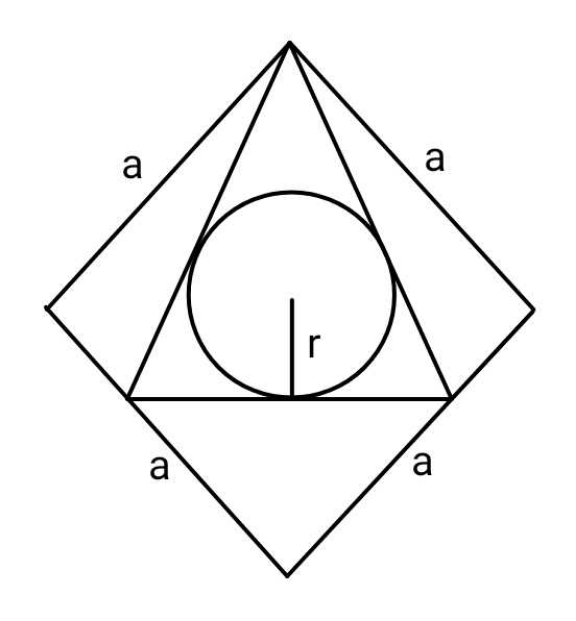
Commented by ajfour last updated on 06/Dec/24

$${Find}\:{maximum}\:{r}.\:{Outer}\:{figure}\:{is}\:{a} \\ $$$${rhombus}.{Circle}\:{is}\:{inscribed}\:{in}\:{an}\: \\ $$$${isosceles}\:{triangle}\:{as}\:{shown}\:{above}. \\ $$
Answered by a.lgnaoui last updated on 07/Dec/24
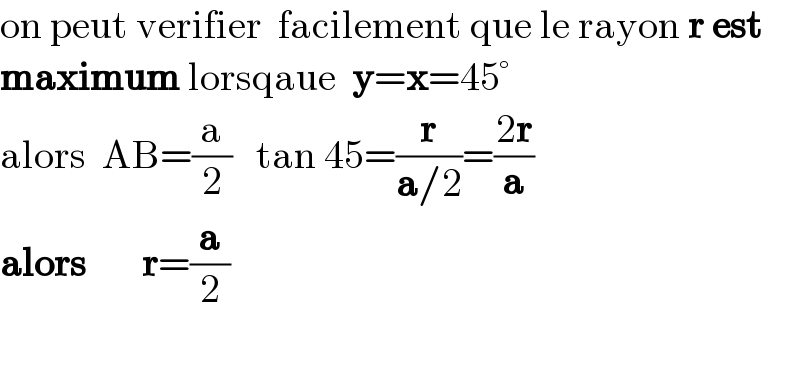
$$\mathrm{on}\:\mathrm{peut}\:\mathrm{verifier}\:\:\mathrm{facilement}\:\mathrm{que}\:\mathrm{le}\:\mathrm{rayon}\:\boldsymbol{\mathrm{r}}\:\boldsymbol{\mathrm{est}}\: \\ $$$$\boldsymbol{\mathrm{maximum}}\:\mathrm{lorsqaue}\:\:\boldsymbol{\mathrm{y}}=\boldsymbol{\mathrm{x}}=\mathrm{45}° \\ $$$$\mathrm{alors}\:\:\mathrm{AB}=\frac{\mathrm{a}}{\mathrm{2}}\:\:\:\mathrm{tan}\:\mathrm{45}=\frac{\boldsymbol{\mathrm{r}}}{\boldsymbol{\mathrm{a}}/\mathrm{2}}=\frac{\mathrm{2}\boldsymbol{\mathrm{r}}}{\boldsymbol{\mathrm{a}}} \\ $$$$\boldsymbol{\mathrm{alors}}\:\:\:\:\:\:\:\boldsymbol{\mathrm{r}}=\frac{\boldsymbol{\mathrm{a}}}{\mathrm{2}} \\ $$$$\:\: \\ $$
Commented by a.lgnaoui last updated on 07/Dec/24
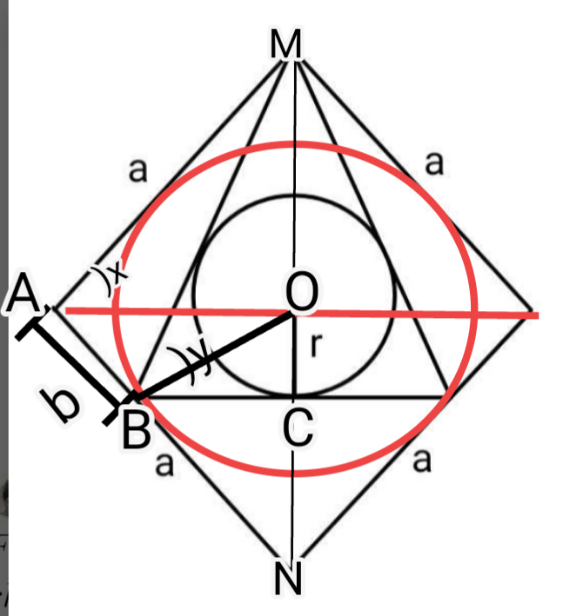
Commented by mr W last updated on 07/Dec/24

$${non}−{sense}\:{again}.\:{the}\:{circle}\:{should} \\ $$$${be}\:{inscribed}\:{in}\:{the}\:{isosceles}\: \\ $$$${triangle},\:{not}\:{in}\:{the}\:{rhombus}! \\ $$
Answered by mr W last updated on 07/Dec/24
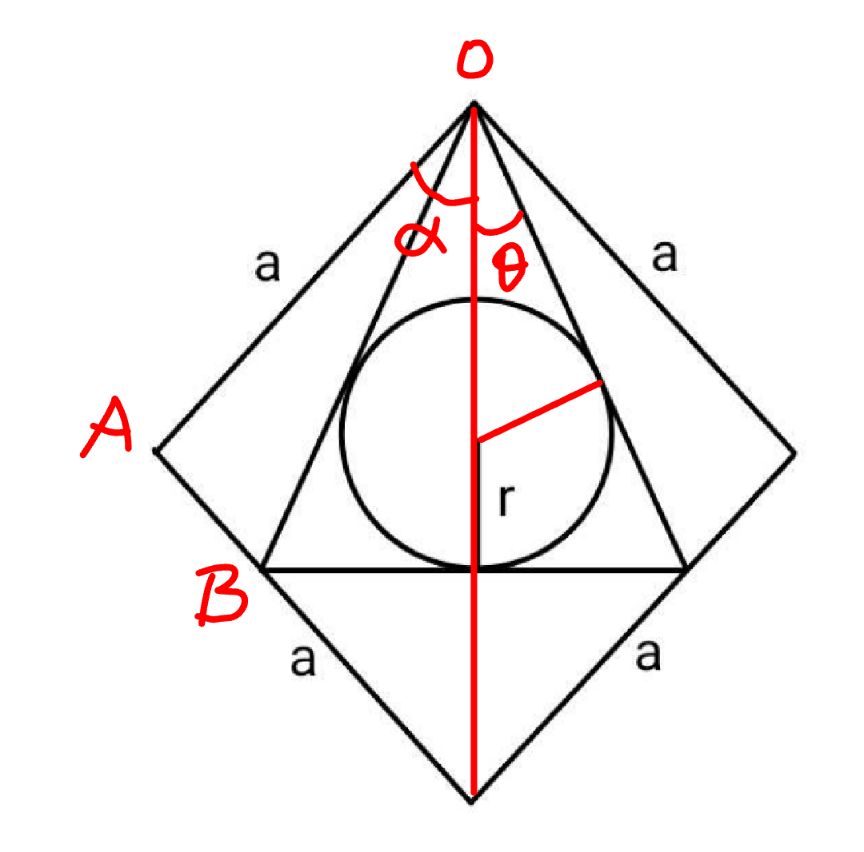
Commented by mr W last updated on 07/Dec/24
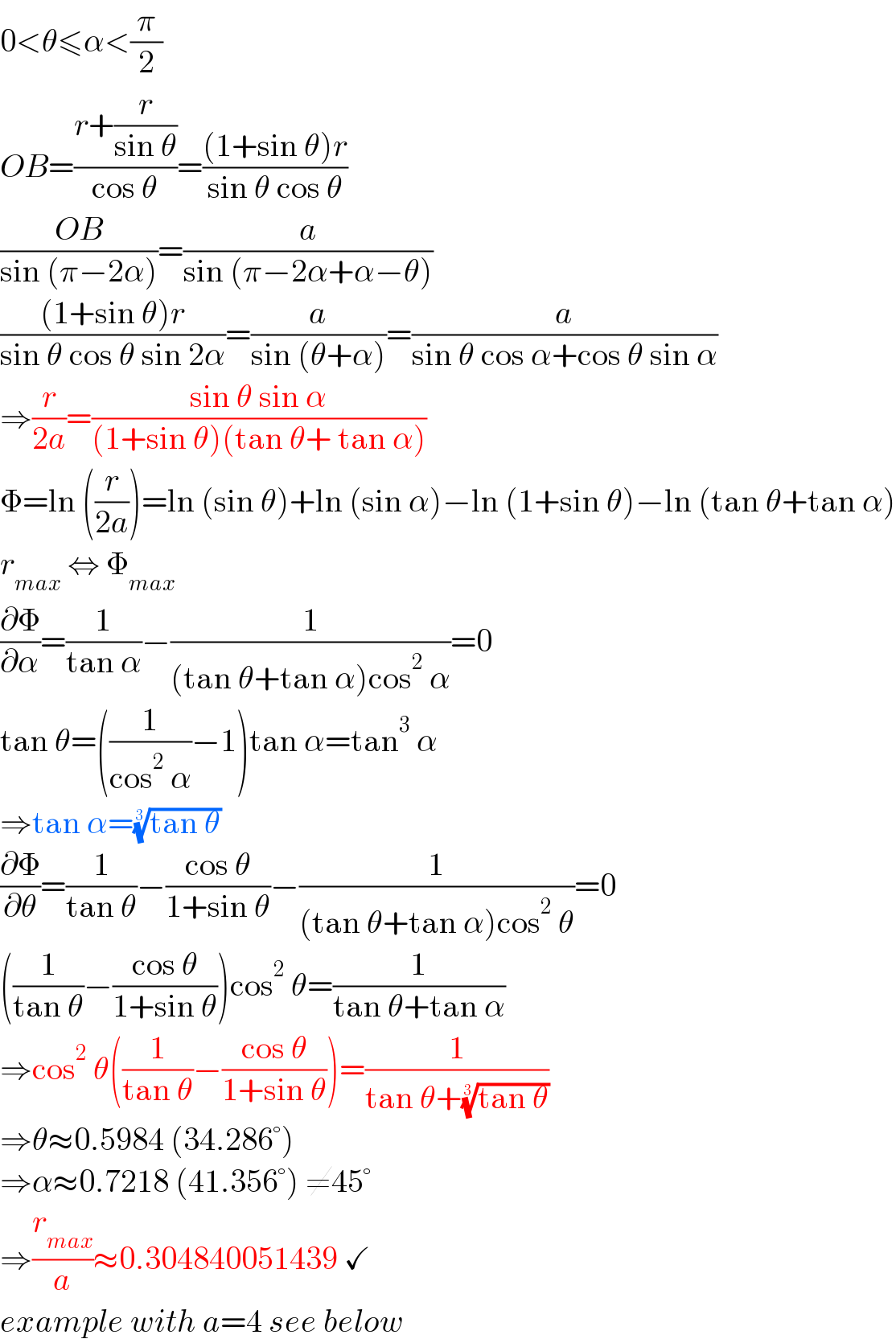
$$\mathrm{0}<\theta\leqslant\alpha<\frac{\pi}{\mathrm{2}} \\ $$$${OB}=\frac{{r}+\frac{{r}}{\mathrm{sin}\:\theta}}{\mathrm{cos}\:\theta}=\frac{\left(\mathrm{1}+\mathrm{sin}\:\theta\right){r}}{\mathrm{sin}\:\theta\:\mathrm{cos}\:\theta} \\ $$$$\frac{{OB}}{\mathrm{sin}\:\left(\pi−\mathrm{2}\alpha\right)}=\frac{{a}}{\mathrm{sin}\:\left(\pi−\mathrm{2}\alpha+\alpha−\theta\right)} \\ $$$$\frac{\left(\mathrm{1}+\mathrm{sin}\:\theta\right){r}}{\mathrm{sin}\:\theta\:\mathrm{cos}\:\theta\:\mathrm{sin}\:\mathrm{2}\alpha}=\frac{{a}}{\mathrm{sin}\:\left(\theta+\alpha\right)}=\frac{{a}}{\mathrm{sin}\:\theta\:\mathrm{cos}\:\alpha+\mathrm{cos}\:\theta\:\mathrm{sin}\:\alpha} \\ $$$$\Rightarrow\frac{{r}}{\mathrm{2}{a}}=\frac{\mathrm{sin}\:\theta\:\mathrm{sin}\:\alpha}{\left(\mathrm{1}+\mathrm{sin}\:\theta\right)\left(\mathrm{tan}\:\theta+\:\mathrm{tan}\:\alpha\right)} \\ $$$$\Phi=\mathrm{ln}\:\left(\frac{{r}}{\mathrm{2}{a}}\right)=\mathrm{ln}\:\left(\mathrm{sin}\:\theta\right)+\mathrm{ln}\:\left(\mathrm{sin}\:\alpha\right)−\mathrm{ln}\:\left(\mathrm{1}+\mathrm{sin}\:\theta\right)−\mathrm{ln}\:\left(\mathrm{tan}\:\theta+\mathrm{tan}\:\alpha\right) \\ $$$${r}_{{max}} \:\Leftrightarrow\:\Phi_{{max}} \\ $$$$\frac{\partial\Phi}{\partial\alpha}=\frac{\mathrm{1}}{\mathrm{tan}\:\alpha}−\frac{\mathrm{1}}{\left(\mathrm{tan}\:\theta+\mathrm{tan}\:\alpha\right)\mathrm{cos}^{\mathrm{2}} \:\alpha}=\mathrm{0} \\ $$$$\mathrm{tan}\:\theta=\left(\frac{\mathrm{1}}{\mathrm{cos}^{\mathrm{2}} \:\alpha}−\mathrm{1}\right)\mathrm{tan}\:\alpha=\mathrm{tan}^{\mathrm{3}} \:\alpha \\ $$$$\Rightarrow\mathrm{tan}\:\alpha=\sqrt[{\mathrm{3}}]{\mathrm{tan}\:\theta} \\ $$$$\frac{\partial\Phi}{\partial\theta}=\frac{\mathrm{1}}{\mathrm{tan}\:\theta}−\frac{\mathrm{cos}\:\theta}{\mathrm{1}+\mathrm{sin}\:\theta}−\frac{\mathrm{1}}{\left(\mathrm{tan}\:\theta+\mathrm{tan}\:\alpha\right)\mathrm{cos}^{\mathrm{2}} \:\theta}=\mathrm{0} \\ $$$$\left(\frac{\mathrm{1}}{\mathrm{tan}\:\theta}−\frac{\mathrm{cos}\:\theta}{\mathrm{1}+\mathrm{sin}\:\theta}\right)\mathrm{cos}^{\mathrm{2}} \:\theta=\frac{\mathrm{1}}{\mathrm{tan}\:\theta+\mathrm{tan}\:\alpha} \\ $$$$\Rightarrow\mathrm{cos}^{\mathrm{2}} \:\theta\left(\frac{\mathrm{1}}{\mathrm{tan}\:\theta}−\frac{\mathrm{cos}\:\theta}{\mathrm{1}+\mathrm{sin}\:\theta}\right)=\frac{\mathrm{1}}{\mathrm{tan}\:\theta+\sqrt[{\mathrm{3}}]{\mathrm{tan}\:\theta}} \\ $$$$\Rightarrow\theta\approx\mathrm{0}.\mathrm{5984}\:\left(\mathrm{34}.\mathrm{286}°\right) \\ $$$$\Rightarrow\alpha\approx\mathrm{0}.\mathrm{7218}\:\left(\mathrm{41}.\mathrm{356}°\right)\:\neq\mathrm{45}° \\ $$$$\Rightarrow\frac{{r}_{{max}} }{{a}}\approx\mathrm{0}.\mathrm{304840051439}\:\checkmark \\ $$$${example}\:{with}\:{a}=\mathrm{4}\:{see}\:{below} \\ $$
Commented by mr W last updated on 07/Dec/24
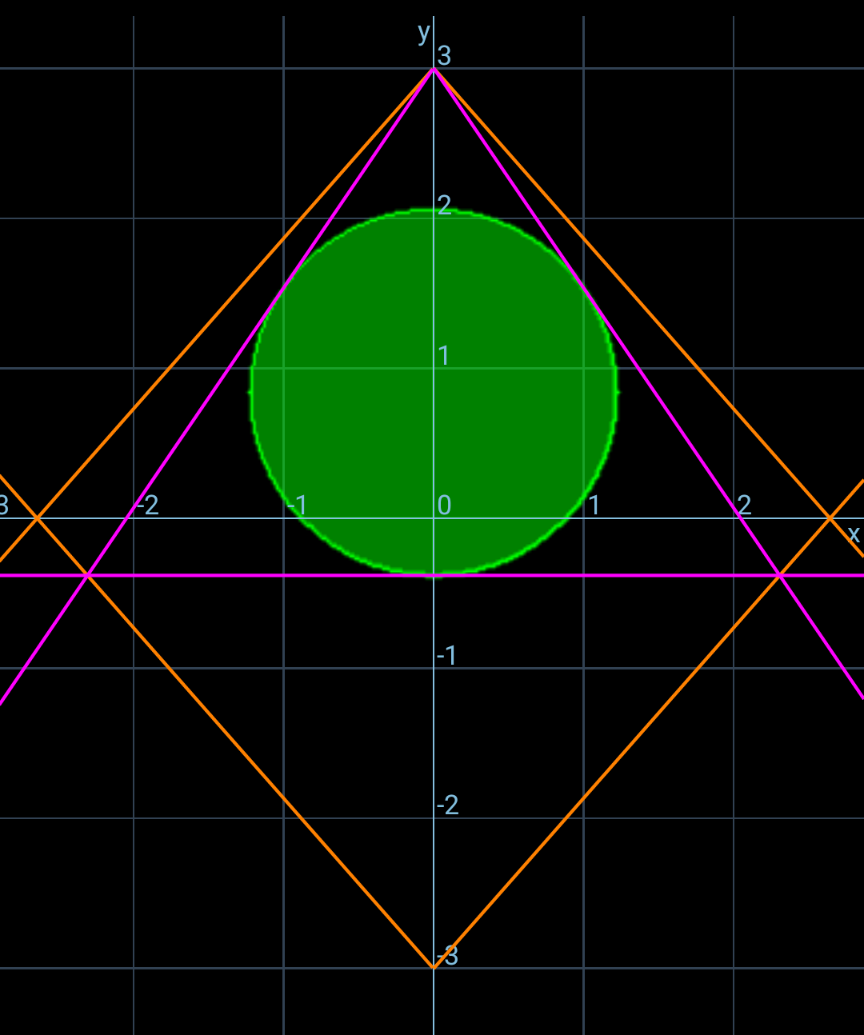
Commented by ajfour last updated on 08/Dec/24

$${Thanks}\:{for}\:{your}\:{solution}.\:{I}\:{am} \\ $$$${trying}\:{still}\:{sometimes}.. \\ $$
